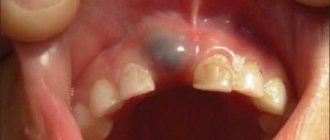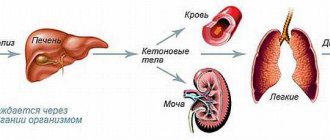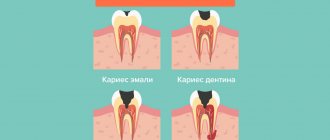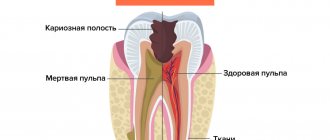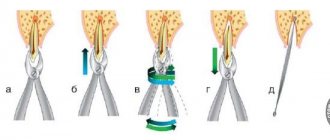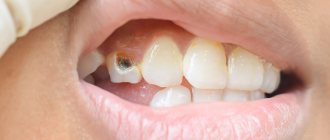If you suddenly have a severe toothache and the pain is throbbing, sharp, unbearable, then such symptoms may indicate tooth pulpitis. What kind of disease is pulpitis, why does it appear, how can it be cured and the tooth saved? We will answer all these questions in detail in this article. After reading the material, you will learn how tooth pulpitis occurs, what methods of its treatment are used in modern dentistry, and whether it is possible to cure tooth pulpitis at home or not.
What is it – tooth pulpitis?
Pulpitis is a dental term that refers to an inflammatory process that affects the nerve bundle inside the tooth - the pulp. Colloquially, the pulp is often called the nerve of the tooth. Strictly speaking, the pulp is not only nerves, but also small blood vessels, thanks to which a living tooth receives nutrients and necessary microelements. If the pulp is removed (and this often happens during the treatment of pulpitis), the tooth becomes dead and fragile because it does not receive the nutrition necessary for its full functioning and healthy condition.
The inflammatory process in the pulp never occurs on its own - there are always reasons that trigger it. Knowing the reasons why pulpitis appears is necessary and useful; this will make it possible to carry out effective prevention of this dental disease.
Take a short test and calculate the cost of treatment!
Take a short test
Inflammation of the nerve in the wisdom tooth
Eights have their own specifics, and the doctor often chooses to remove the tooth. The complexity of therapy is due to the anatomical features of the third molars. Curved roots, lack of access to the tooth, partial overlap of the gums equates the treatment of pulpitis in figure eights to jewelry work. And it requires experience and high qualifications of a doctor.
An inflamed nerve in a wisdom tooth can be treated by filling the canals. Provided that there is access to the root and the dental canals have good patency. It makes sense to preserve a tooth in the presence of an antagonist tooth, if the tooth is involved in the chewing process and is used when installing a prosthesis.
Causes of pulpitis
The main reason causing the development of pulpitis is caries, the treatment of which was not carried out on time. If a person delays treatment of caries until the last minute and does not go to the dentist, his risk of encountering pulpitis is extremely high, because caries is a constantly progressive disease that destroys tooth tissue. And sooner or later the destructive process reaches the pulp. Therefore, one of the basic principles of pulpitis prevention can be formulated as follows: if you don’t want to encounter pulpitis, don’t delay caries treatment!
Treatment of pulpitis will be much more complex and expensive than treatment of caries. Moreover, when treating advanced pulpitis, it is not always possible to save a tooth. Therefore, you need to forget about the fear of dentists and always consult a doctor in a timely manner for the treatment of caries! Nowadays, there are technologies that make it possible to successfully treat caries without pain and discomfort for the patient - for example, dental treatment under sedation, treatment without drilling a tooth.
Less commonly, pulpitis and the need for its treatment may arise for the following reasons:
1. Low quality of dental treatment. If, when treating caries, the dentist incorrectly treats the carious cavity or makes other mistakes and inaccuracies, tooth pulpitis may develop under the installed permanent filling.
2. Low quality of teeth preparation for prosthetics. Before prosthetics, the teeth are ground for the future prosthesis, and if, while working with a living tooth, the dentist overheats its tissues, pulpitis may develop. This will not happen immediately, but after some time, but pulpitis under the crown is almost always a sign of poor quality work by the orthopedic doctor. To treat pulpitis, the crown will have to be removed.
If you do not want to encounter pulpitis and other complications after poor-quality dental treatment, you must remember one simple rule: for dental treatment, you should not choose a clinic at the lowest price, but find out all the available information on its equipment and the level of qualifications of the doctors working there!
3. The cause of the development of pulpitis can also be gum disease. For example, periodontal disease causes exposure of tooth roots, and at the same time, a deep periodontal pocket is formed in the area of contact between the gum and tooth, in which pathogenic microorganisms will actively develop, causing the appearance of caries and then pulpitis. Therefore, treatment of gum inflammation also does not need to be postponed; if you see that your gums are inflamed, be sure to visit the dentist’s office!
Very rarely, pulpitis occurs due to injuries leading to tooth fracture. If the injury damaged not only the pulp, but also the root of the tooth, the only treatment that can be done is to remove the tooth.
For whatever reasons, pulpitis appears, its treatment must be carried out as urgently as possible. Timely and high-quality treatment of pulpitis makes it possible to keep the tooth alive, and, as you know, your natural teeth are better than any dentures!
How to deal with the disease
At the initial stage, it is not difficult to cope with pulpitis. The nerve in the tooth is preserved, and the doctor relieves the inflammation using therapeutic procedures.
The biological treatment method eliminates inflammation through antibacterial treatment of the damaged tooth, without removing the nerve. After removing carious tissue and disinfecting the pulp chamber, the dentist applies a compress with calcium hydroxide and fixes a temporary filling.
Then, after 3-7 days, during a follow-up visit, the doctor takes an x-ray. If there is no inflammatory process, then a permanent filling is installed. However, this technique requires a highly qualified doctor, so it is rarely used. For example, with traumatic inflammation of the dental nerve.
Preserving the pulp is important because... If it is present, the tooth is constantly strengthened due to the production of dentin. Conservative therapy has age restrictions - it is carried out up to 30 years.
Symptoms of tooth pulpitis
How can you determine that your tooth hurts precisely because of the development of pulpitis? This disease has its own characteristic symptoms and the first sign of the development of pulpitis may be pain that occurs when a diseased tooth comes into contact with cold/hot, sweet/sour foods. Unlike pain during caries, these sensations do not go away immediately after the irritant that caused them is eliminated: they persist for longer than 15 minutes. If you are bothered by such sensations during and after eating, you need to urgently contact your dentist for diagnosis and treatment of pulpitis.
It is important to understand that without proper treatment, pulpitis will not go away: the inflammatory process will continue to develop and this will lead to the transition of pulpitis to an acute form. In acute pulpitis, pain can occur suddenly and on its own, without external influence. Pus collects in the pulp, and if there is no natural outlet for its outflow, it begins to put pressure on the bundle of nerves, and severe pain occurs.
At first, this pain can be eliminated by taking tablets from the pharmacy, but if treatment for pulpitis is not carried out, pharmacy painkillers will no longer help. The pain will be excruciating and constant, moreover, it can spread along the nerve endings to different parts of the oral cavity. For this reason, people who go to the doctor for treatment of acute pulpitis often cannot pinpoint exactly which tooth is hurting. In acute pulpitis, swelling of the gums and increased body temperature may be observed.
Pulpitis is not only acute - it has its own fairly extensive classification into various forms, and each form of pulpitis has its own symptoms. Accurate determination of the form of pulpitis is of fundamental importance for choosing an effective method of treating it. Below we will look at all seven main forms of pulpitis and their main symptoms.
Fibrous pulpitis of the tooth
The development of a fibrous form of pulpitis may be indicated by mild, aching pain, which occurs most often when a tooth comes into contact with hot/cold food during chewing. The pain is usually localized quite clearly - in one tooth. If fibrous pulpitis is not treated in time, then as the disease develops, pain may appear on its own and not stop for 24-48 hours.
Hypertrophic form of pulpitis
With this form of pulpitis, patients who go to the doctor for treatment complain of a viscous, aching pain, which often occurs when eating. This pain causes people to avoid chewing on the side of the jaw where the painful tooth is located. Another sign of hypertrophic pulpitis may be bleeding gums that appear when brushing teeth in the area of inflammation.
Gangrenous pulpitis and its symptoms
This form of pulpitis is also characterized by aching pain that occurs under the influence of chewing load on the teeth or from contact of the diseased tooth with temperature irritants. A person with the development of gangrenous pulpitis may experience the appearance of extremely unpleasant odor from the mouth, which cannot be removed by the standard procedure of brushing teeth and rinsing with balms. When, when treating gangrenous pulpitis, the dentist opens the tooth cavity, thick gray pus with a fetid odor is found in the area of inflammation.
Chronic pulpitis and signs indicating its development
This form of pulpitis is insidious in that it may not show itself for a long time.
Chronic pulpitis can be detected only after diagnostic measures are carried out or when it transforms into an acute form, which has bright and pronounced symptoms. Acute pulpitis, which has not been treated, can become chronic. But you shouldn’t think that you can continue to calmly live with a bad tooth and not take any measures to treat it. Chronic pulpitis sooner or later turns into acute and then a person is simply forced to see a doctor, because the pain becomes unbearable and pills from the pharmacy cannot save it.
To choose an effective treatment method, you need to conduct a high-quality diagnosis that allows you to determine the form of pulpitis and the stage of development of inflammation.
Surgery
Surgical methods for treating pulpitis are divided into vital and devital (with preliminary killing of the pulp). Indications for the use of vital methods are:
- Acute diffuse pulpitis
- Acute focal pulpitis
- Chronic pulpitis of fibrous and hypertrophic type
Vital extirpation (removal) of the pulp is performed under local (conduction) anesthesia. The affected tooth is isolated with sterile pads or a latex scarf to prevent saliva from entering. After this, the carious cavity is opened and treated with an antiseptic. The coronal part of the pulp is removed using a pulp extractor, after which the mouths of the root canals are opened and the root pulp is also removed. The next stage is expansion of the canals, treating them with an antiseptic and subsequent filling. After X-ray quality control of the filling, the crown part of the tooth is restored.
Devital methods of pulp removal involve its preliminary destruction using a special paste - depulpin. They are recommended for use in the treatment of patients who have a strong fear of injection anesthesia or suffer from allergies to painkillers, as well as if the patient has serious somatic diseases. The advantage of the devital method is that there is no risk of bleeding during mechanical treatment of the canals. However, choosing the correct anesthetic dosage can be challenging; In addition, depulpin should never be left inside the tooth for too long, as this can lead to the death of healthy tissue. In addition, a pulpless tooth becomes more fragile, and in most cases, after extirpation, it is necessary to reinforce the tooth with a pin or cover it with a crown.
Preparations for rubbing and lotions
- Coniferous tree resin. A small piece of resin is held on the damaged area until dissolved. A disinfectant that suppresses the inflammatory process.
- Lard - used to eliminate pain - a piece of lard is placed in the carious cavity.
- Garlic juice is used as an anesthetic. Rubbing is carried out several times a day.
- Ginger – restores nutrition and blood supply to the pulp. Fresh ginger and soda are poured with boiling water.
- Pomegranate peel not only reduces pain and inflammation, but is also a prophylactic against pulp suppuration. The pomegranate peel is crushed, poured with boiling water, and left for two hours.
- To disinfect and relieve swelling, use an infusion of bay leaves, a mixture of knotweed with elderberry flowers.
- Coniferous tree resin localizes inflammation and disinfects the affected area.
- St. John's wort and calamus root are known as the basis for the preparation of an anti-inflammatory agent.
How does pulpitis occur?
The occurrence of pulpitis
It is generally accepted that caries, especially in an advanced stage, is the most common cause of pulpitis. However, the development of the disease can also be a consequence of tooth trauma, and a consequence of improper treatment by an unqualified dentist.
There are several ways of infection of the pulp and, as a consequence, the occurrence of pulpitis:
- through the crown of the tooth, when the carious cavity grows, becoming a gateway for the penetration of microbes and pathogenic bacteria into the dentin and further into the pulp;
- through the apex of the tooth root (retrograde pulpitis).
Due to its specific pathogenesis, retrograde pulpitis is a rather rare occurrence. The following factors can provoke it:
- infection of the pulp through the blood in systemic viral diseases such as rubella or herpes;
- infection of tooth roots through the maxillary sinuses during sinusitis.
At the same time, one of the most common causes of pulpitis are dental errors:
- a poorly treated carious cavity is untreated caries, which leads to re-infection of dentin and the development of caries already under the filling;
- thermal burn of the pulp due to insufficient water cooling or overdrying of the tooth cavity during treatment;
- chemical damage to tooth tissue during treatment.
! You can protect yourself from the consequences of treatment by an unscrupulous dentist in advance by contacting a well-known dental clinic with a name and reputation. High-tech equipment, the availability of modern equipment and a staff of professional dentists will allow you to undergo a full diagnosis and receive timely, qualified treatment.


